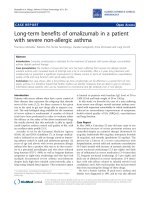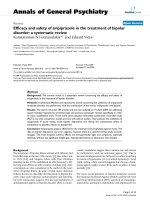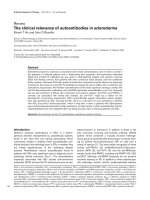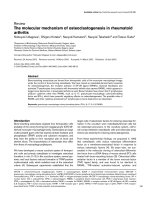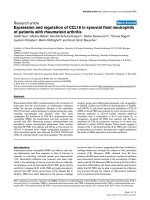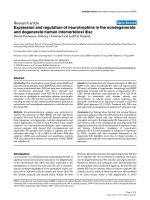Báo cáo y học: "No increased risk of infant hypospadias after maternal use of loratadine in early pregnancy"
Bạn đang xem bản rút gọn của tài liệu. Xem và tải ngay bản đầy đủ của tài liệu tại đây (173.2 KB, 2 trang )
Int. J. Med. Sci. 2006, 3
106
International Journal of Medical Sciences
ISSN 1449-1907 www.medsci.org 2006 3(3):106-107
©2006 Ivyspring International Publisher. All rights reserved
Short research communication
No increased risk of infant hypospadias after maternal use of loratadine in early
pregnancy
Bengt Källén, Petra Otterblad Olausson
Tornblad Institute, University of Lund, and Swedish National Board of Health and Welfare, Stockholm, Sweden
Corresponding address: Professor Bengt Källén, Tornblad Institute, Biskopsgatan 7, SE-223 62 Lund, Sweden.
Received: 2006.04.28; Accepted: 2006.05.25; Published: 2006.06.01
The original report published in 2001 on a possible association between maternal use of loratadine and an increased
risk of infant hypospadias, based on data in the Swedish Medical Birth Register 1995-2001, has been followed up by
continued surveillance in the same register. The original “signal” was based on 15 infants with hypospadias among
2780 loratadine-exposed infants born, representing an adjusted odd ratio of about 2.3, statistically significant. Since
then another 10 cases have been identified, and 12.5 expected. For the period 2001-2004, another 1911 loratadine-
exposed infants have been identified and only two had hypospadias (4 expected). Our present position is that the
primary finding was a “signal” which had occurred by chance and the follow-up agrees with independent studies
which indicate an absence of an association. This illustrates the care with which apparent statistically significant
increases have to be handled when no prior hypothesis exists.
Key words: Hypospadias, loratadine, pregnancy, drug safety.
1. Introduction
In a recent issue of International Journal of Medical
Sciences, a study was published based on a prescription
register in Denmark which indicated an absence of an
association between maternal use of loratadine and an
increased risk for hypospadias in the offspring [1]. The
reason for that study was a report we wrote [2] which
described a system for an ongoing monitoring of
maternal drug use and infant congenital malformations.
As an example we presented the finding that maternal
use of loratadine in early pregnancy was associated with
a roughly doubled risk for infant hypospadias. We
concluded: “The finding can still be random, but
causality cannot be dismissed, even though the
mechanism of action is not understood”.
A reason for publishing a finding of this type is of
course to encourage other scientists to look at their data
sources to evaluate if the finding is supported or
contradicted. Two small studies were published [3,4]
which showed no such association but both were
underpowered (210 and 161 women, respectively) and a
study from CDC, using data from the National Birth
Defects Prevention Study [5], found no association in a
retrospective case-control study of 563 infants with
hypospadias and 1444 male controls.
The finding also caused two experimental studies:
one performed by the drug company and using rats [6]
which was negative and one [7] using mice which was
positive.
A further possibility to evaluate the assumed
association is the continue surveillance in the original
system. This we have done and present here the results.
2. Materials and Methods
Our study is – like our previous study - based on the
nationwide Swedish Medical Birth Register which
contains information on maternal use of drug as reported
and registered in early pregnancy [2, 8]. This information
is based on interviews performed by midwifes and the
system has been working since July 1, 1994 which makes
it possible to collect a large number of pregnancies where
the women used a drug (prescription or over-the counter)
and to study offspring for various characteristics,
including congenital malformations. Outcome is based on
the recording of the attending paediatrician. It is known
that for rather mild malformations like hypospadias,
recording in the Medical Birth Register is incomplete. In
our previous study we supplemented the information
with data from the Swedish Register of Congenital
Malformations, a surveillance register to which cases of
hypospadias would be reported – before 1999 only cases
with the urethral orifice in or behind the coronary sulcus.
In the present study, data from the Hospital Discharge
Register have been added. This register contains
discharge diagnoses from all inpatient care in the country.
Children with hypospadias will therefore be identified
also when they, perhaps years after birth, undergo
reconstructive surgery. A description of the system of
ascertainment of malformed infants from various sources
is available [9].
We previously studied births up to and including
2001. We now supplemented those data with cases more
recently identified (from the Hospital Discharge Register)
and made a new study of births during 2002-2004.
Risks were estimated as risk ratios (RR) with exact
95% confidence intervals (95% CI) from exact Poisson
distributions. RR was determined as the observed
number of cases divided with the expected number,
calculated from the total population after adjustment for
year of birth, maternal age, parity, and smoking in early
pregnancy.
3. Results
In the repeated analysis of the first period (up to and
including 2001) we restricted births to those occurring
Int. J. Med. Sci. 2006, 3
107
after July 1, 1995 and searched the registers for all known
cases of hypospadias. The total number of loratadine-
exposed infants is then 2780 and 25 had hypospadias
identified (0.9%) - ten of the cases were thus ascertained
from the Hospital Discharge Register after the neonatal
period. The expected number is 12.5 and RR = 2.0 (95% CI
1.29-2.95). The risk is slightly but not significantly lower
than that given in our first study (RR =2.39, 95% CI 1.43-
3.38).
For the period 2002-2004 (inclusive), we identified
1911 infants exposed to loratadine – only two had
hypospadias. The expected number, calculated as above,
was 4.3 and RR = 0.47 with a 95% CI 0.06-1.68).
The rates of hypospadias during the two
observation periods (25 among 2780, 2 among 1911) are
highly significant different (p<0.001).
For the total observation period there were thus 27
cases with an expected number of 16.8, RR = 1.61, 95%CI
1.04-2.34).
4. Discussion.
This is a typical situation which arises in any kind of
surveillance: a clear-cut “signal” appears which is
formally statistically significant. As there is no prior
hypothesis and at the surveillance process we study a
large number of “exposures” (in this case drugs) and
many outcomes (in this case different types of congenital
malformations) it is to be expected that a number of
apparently significant associations will occur. In this
situation there are a number of problems: to publish or
not to publish and also how such a finding should be
handled by authorities.
If such a “signal” is published it is imperative to
stress that in spite of formal statistical significance, the
finding may be random and the reason for publishing is
of course to ask other researchers to look for the presence
or absence of that specific association. It is often thought
that if there is a biological plausibility in the finding or if
it can be repeated in animal experiments, it is more likely
to be true. It should be remembered, however, that there
was no biological plausibility when thalidomide was
detected as a human teratogen, and animal experiments
may be difficult to interpret. In the case of loratadine,
both negative and positive animal findings have been
published [6, 7].
New studies from independent materials are the
first option. When a very strong teratogenic effect is
expected it may be relatively easy to verify or reject an
observation. When the “signal” refers to a rather weak
effect (a 2-3 times increase in risk) and the exposure rate
is not very high as was the case with loratadine, it may be
very difficult to identify materials large enough and of
enough quality to get meaningful information. In the
example of loratadine and hypospadias, two very small
studies [3, 4] which were anyway published had in fact
no power whatever to detect the assumed effect of
loratadine, and a larger retrospective case-control study
[5] was restricted to relatively severe cases and used
retrospective data on drug exposure. The most recent
study [1] was based on prescription data and therefore
uncertain exposure information and in spite of its size of
319 hypospadias cases found an adjusted OR for
hypospadias after loratadine exposure during the first
trimester with an upper confidence limit of 10.5. The
authors calculate that in order to rule out a doubling of
the risk, they would need a more than four times larger
material.
The next strategy, which is the basis of the present
study, is continued surveillance. This necessitates the
presence of an ongoing surveillance system which is the
case with the Swedish Medical Birth Register. The follow-
up performed gave no evidence for an association
between maternal use of loratadine and hypospadias and
the rate of hypospadias among loratadine-exposed
infants was highly significantly lower than that during
the first period. There are two possible explanations. The
noticed effect of loratadine during the first period could
be the result of a synergism with an unknown factor – a
search for such a factor has yielded no likely candidate.
The second possibility, which is much more probable, is
that the first “signal” was the result of multiple testing
and was therefore not repeated at follow-up.
5. Conclusion
Present evidence suggests that the earlier observed
association between maternal use of loratadine in early
pregnancy and birth of infants with hypospadias was the
result of multiple testing.
Acknowledgments
The study was supported by a grant from K A
Wallenberg Foundation, Sweden, to BK.
Conflict of interest
The authors have declared that no conflict of interest
exists.
References
1. Pedersen L, Vinther Skriver M, Nørgaard M, Sørensen HT. Maternal
use of Loratadine during pregnancy and risk of hypospadias in
offspring. Int J Med Sci 2006; 3: 21-5.
2. Källén B, Otterblad Olausson P. Monitoring of maternal drug use
and infant congenital malformations. Does loratadine cause
hypospadias? Int J Risk Safety Med 2001; 14: 115-9.
3. Diav-Citrin O, Schechtman S, Aharonovich A, et al. Pregnancy
outcome after exposure to loratadine or antihistamines: a
prospective controlled cohort study. J Allergy Clin Immunol 2003;
111: 1239-43.
4. Moretti ME, Caprara D, Coutinho CJ, et al. Fetal safety of loratadine
use in the first trimester of pregnancy: a multicenter study. J Allergy
Clin Immunol 2003; 111: 479-483.
5. Centers for Disease Control and Prevention. Evaluation of an
association between loratadine and hypospadias-United States 1997-
2001. MMWR Morb Mortal Wkly Rep 2004; 53:219-21.
6. McIntyre BS, Vancutsem PM, Treinen KA, Morrissey RE. Effects of
perinatal loratadine exposure on male rat reproductive organ
development. Reprod Toxicol 2003; 17: 691-7.
7. Willingham E, Agras K, Vilela M, Baskin LS. Loratadine exerts
estrogen-like effects and disrupts penile development in the mouse.
J Urol 2006; 175: 723-6.
8. [Internet] National Board of Health and Welfare, Centre for
Epidemiology. The Swedish Medical Birth Registry – a summary of
content and quality. />3/2002-112-3.pdf.
9. [Internet] National Board of Health and Welfare, Centre for
Epidemiology. Registration of Congenital Malformations in the
Swedish Health Registers.
/>1.htm



